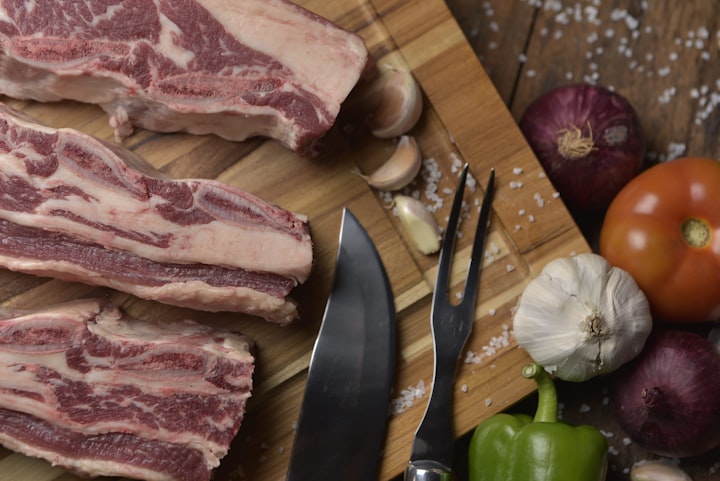Is eating PORK is good for humans HEALTH? It is more tasty then chicken and mutton ?
Uses and cons

Is eating PORK is good for humans HEALTH? It is more tasty then chicken and mutton ?

There is much debate about the health benefits of eating pork. While it is a popular meat consumed in many parts of the world, some people avoid it due to concerns about its impact on health. In this blog, we will explore the health benefits and risks of eating pork, and help you decide whether it should be part of your diet.
Nutritional Value of Pork
Pork is a rich source of protein, vitamins, and minerals. It contains all nine essential amino acids that our body needs to build and repair tissues. Additionally, pork is rich in B-vitamins, which are essential for energy production, metabolism, and brain function. Pork is also a good source of zinc, selenium, and iron, which are important for immune function and healthy red blood cells.
However, pork is also high in fat, particularly saturated fat, which can increase the risk of heart disease and other health problems. Therefore, it is important to choose lean cuts of pork, such as tenderloin, loin chops, or sirloin, and trim any visible fat before cooking.
Health Benefits of Eating Pork
Protein Source: Pork is a rich source of high-quality protein, which is essential for building and repairing tissues in the body.
Vitamin B1: Pork is also a good source of vitamin B1, which helps to maintain a healthy nervous system and is important for energy production.
Zinc: Pork is a good source of zinc, which plays a crucial role in immune function and wound healing.
Selenium: Pork is also a good source of selenium, which is important for thyroid function and helps to protect cells from damage.
Iron: Pork is a good source of iron, which is essential for healthy red blood cells and oxygen transport throughout the body.
Risks of Eating Pork
High in Fat: As mentioned earlier, pork is high in fat, particularly saturated fat, which can increase the risk of heart disease and other health problems.
Nitrates and Nitrites: Some pork products, such as bacon and ham, are processed and may contain nitrates and nitrites, which have been linked to an increased risk of certain cancers.
Trichinosis: Raw or undercooked pork can be contaminated with a parasite called Trichinella spiralis, which can cause trichinosis, a rare but serious illness.
Processing: Some pork products, such as bacon and ham, are processed and may contain nitrates and nitrites, which have been linked to an increased risk of certain cancers.
Religious and Cultural Concerns: Some religions and cultures do not consume pork due to religious or cultural beliefs. For example, Muslims and Jews do not eat pork as it is considered haram or not kosher, respectively.
Environmental Impact: Pork production can have a significant environmental impact, including deforestation, water pollution, and greenhouse gas emissions. This can contribute to climate change and other environmental problems.
Different ways to cook pork:
Roasting: Roasting pork in the oven is a classic way to cook pork. A whole pork loin or pork shoulder can be seasoned with herbs and spices and roasted until tender and juicy.
Grilling: Grilling pork over an open flame is another popular way to cook it. Pork chops, pork tenderloin, and pork ribs can all be grilled to perfection.
Braising: Braising involves cooking pork in a liquid, such as stock or wine, over low heat for a long period of time. This method is perfect for tougher cuts of pork, such as pork shoulder, and results in tender, flavorful meat.
Frying: Frying pork is a popular method of cooking in many cuisines. Breaded and fried pork chops, schnitzel, and tonkatsu (Japanese breaded pork cutlets) are all examples of fried pork dishes.
Slow Cooking: Slow cooking pork in a crockpot or slow cooker is a convenient way to cook pork. Pork shoulder or pork loin can be seasoned and cooked on low heat for several hours, resulting in tender and flavorful meat.
Smoking: Smoking pork is a popular way to cook it in many parts of the world. Pork ribs, pulled pork, and smoked ham are all examples of smoked pork dishes.
Stir-Frying: Stir-frying pork is a quick and easy way to cook it. Pork strips or ground pork can be quickly stir-fried with vegetables and seasonings for a delicious and nutritious meal.
Conclusion
Eating pork can be part of a healthy and balanced diet, as long as it is consumed in moderation and in lean cuts. It provides essential nutrients such as protein, B-vitamins, zinc, selenium, and iron. However, it is important to be mindful of the risks associated with consuming pork, including its high fat content and the potential for contamination with nitrates, nitrites, and Trichinella spiralis. Therefore, it is recommended to cook pork thoroughly and to choose unprocessed or minimally processed pork products whenever possible.






Comments
There are no comments for this story
Be the first to respond and start the conversation.